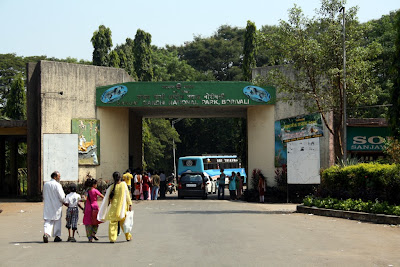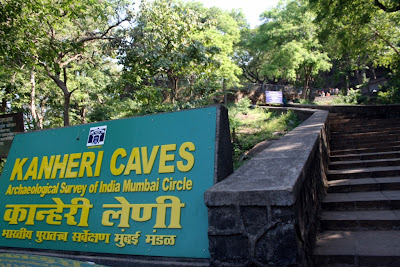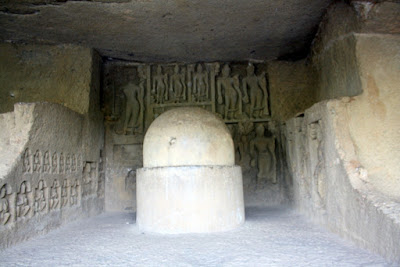At the northern tip of Mumbai, in Borivili, lies the magnificent Sanjay Gandhi National Park.

It is the breathing space for stressed out Mumbaikars who wish to go birding, or just a walk in the forest!
 Nestled in the green environs are the glorious Kanheri caves. These caves date back to 11th century AD and beyond. As per the records work on these caves began in 1st century BC and carried on right through 11th century AD. It is 6 km from the National Park Main Gate. Kanheri comes from the Sanskrit word Krishnagiri generally meaning black in colour. They were chiseled out of a massive basaltic rock outcropping.There are 109 rock-cut cells, carved into the side of a hill. Each cave has a stone plinth for a bed. A congregation hall with huge stone pillars contains the stupa, a Buddhist shrine.
Nestled in the green environs are the glorious Kanheri caves. These caves date back to 11th century AD and beyond. As per the records work on these caves began in 1st century BC and carried on right through 11th century AD. It is 6 km from the National Park Main Gate. Kanheri comes from the Sanskrit word Krishnagiri generally meaning black in colour. They were chiseled out of a massive basaltic rock outcropping.There are 109 rock-cut cells, carved into the side of a hill. Each cave has a stone plinth for a bed. A congregation hall with huge stone pillars contains the stupa, a Buddhist shrine. Farther up the hill are the remains of an ancient water system, canals and cisterns that collected
Farther up the hill are the remains of an ancient water system, canals and cisterns that collected  and channeled the rainwater into huge tanks. Most of the caves are the Buddhist viharas meant for living, study, and meditation. The larger caves were chaityas, or halls for congregational worship, are lined with intricately carved Buddhist sculptures, reliefs and pillars, and contain rock-cut stupas for congregational worship.
and channeled the rainwater into huge tanks. Most of the caves are the Buddhist viharas meant for living, study, and meditation. The larger caves were chaityas, or halls for congregational worship, are lined with intricately carved Buddhist sculptures, reliefs and pillars, and contain rock-cut stupas for congregational worship. 
The large number of viharas obviously prove a well-organized existence of Buddhist monks' establishment. Kanheri was a University center by the time the area was under the rule of the Maurayan and Kushan empires. It is credited with the largest number of cave excavations in a single hill and it thrived due to its proximity to ancient sea port towns like Sopara (Surparaka, the Supara of Greek; Subara of Arab writers; the ancient capital of northern Konkan), Kalyan a thriving port. It is generally believed that Buddhism first arrived in Aparantha (Western India) at Sopara which is very close to Kanheri. The caves were mentioned by early visitors like the Portuguese in the 16th century A.D. and other travellers and voyagers of Europe. Of the numerous donor inscriptions found here mention of ancient cities like Suparaka (Sopara); Nasika (Nasik); Chemuli (Chemula); Kalyana (Kalyan); Dhenukakata (Dhanyakataka, modern Amaravati in Guntur district of Andhra Pradesh) are found. The donors were from all class of the society, from the members of the royal families to the commoners.

There are evidences of provision of wooden rafters to the vaulted ceiling of nave which are gone now. 

The pillars of the hall are not uniform and of different styles and shapes and devoid of symmetry. 

A stupa is provided at the apse of the hall which measures 4.9 m in diameter and 6.7 m in height.
 The façade of the hall is pierced by three doors with two groups of two couples, each group
The façade of the hall is pierced by three doors with two groups of two couples, each group 
carved in the oblong recesses between the doors. A huge chaitya window bereft of any ornamentation was provided for the passage of light.

The side walls are sculpted extensively with two massive images of standing Buddha in varada
 mudra and other Bodhisattva images. These sculptures are of later additions and are datable to around 5th – 6th centuries A.D.
mudra and other Bodhisattva images. These sculptures are of later additions and are datable to around 5th – 6th centuries A.D. Cave 11 which is also known as ‘Darbar Hall’ consists of a huge hall with a front verandah.
Cave 11 which is also known as ‘Darbar Hall’ consists of a huge hall with a front verandah.

The hall has a shrine on its back wall and cells on two sides. The floor of the hall two low stone benches resembling Cave 5 of Ellora.

Buddha in dharmacakrapravardana mudra adorns the shrine.

The cave has four inscriptions of different periods, one dated in Saka 775 (A.D. 853) of the reign of Rashtrakuta King Amoghavarsha and his feudatory the Silahara prince, Kapardin. The inscription records the donation of various gifts and funds provided for the purchase of books and repairs to the damages.Even if you are not a history buff, it is worth the visit for the

wonderful views that you get on the way to the top and from the top. It is an invigorating trip that one would not mind, whether one has interests in history, culture or just plain adventure.
Nearest Railway Station: Borivili on the Western sector.
Entrance fee to the Park: Rs20/-per head and Rs.50/-per vehicle.
Entrance to Kanheri caves: Rs.5/-per head.
Timings: 0730hrs to 1730hrs.
Buses available from Main entrance to the caves at regular intervals at Rs.30/-per head.